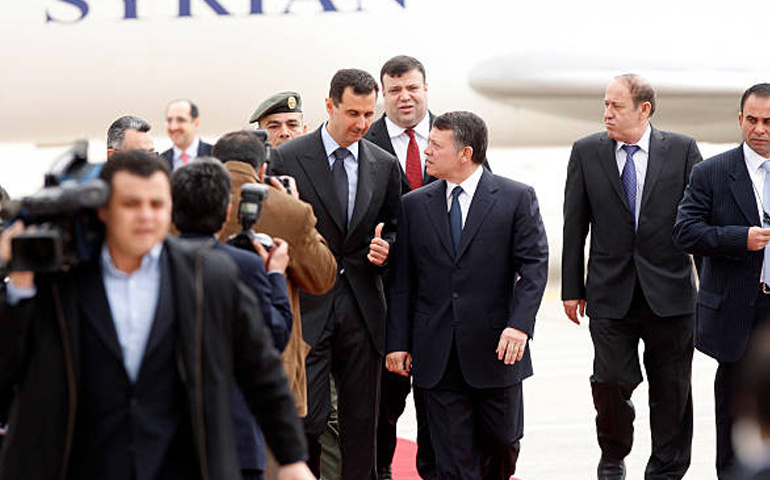Bashar al-Assad with Jordan’s King Abdullah in March 2009
Jordan’s plan for “normalization” with Syria’s Assad regime reportedly includes proposals for the curbing of Iranian influence and the withdrawal of US forces.
Jordan, the UAE, and Egypt have moved to open relations with Damascus after more than a decade of isolation of Bashar al-Assad because of the regime’s repression and war crimes.
In August, King Abdullah reportedly discussed the new approach in meetings in Washington. In late September, Jordan fully reopened the Naseeb crossing, one of the most important trade routes in the Middle East, on the border with southern Syria. Soon after that, King Abdullah spoke with Assad by phone for the first time since the Syrian uprising began in March 2011.
See also Biden Administration: Jordan Can Restore Relations with Assad Regime
Writing for Asharq al-Awsat, Ibrahim Hamidi sets out a six-page Jordanian “non-paper” which purportedly sets out the Kingdom’s approach to renewed relations with Assad. The proposals were prepared before Abdullah’s discussions with the Biden Administration in August as well as meetings with Russian President Vladimir Putin and with Arab leaders.
At the heart of the document is a trade: the forces of the US-led coalition will leave northeast Syria, including withdrawal from the Tanf base on the Iraq border. Meanwhile, the “step-by-step” approach will “curb Iranian influence in certain parts of Syria”.
Significantly, the document does not make the same demand of Moscow’s air and ground forces, essential to propping up the Assad. Instead, it “recognizes the legitimate interests of Russia” with agreement with Moscow on how to proceed.
The non-paper promotes “a gradual change in the behavior” of the Assad regime, saying that the alternative of “regime change” has failed. However, it is vague on how Assad’s repression can be eased and Syrian rights ensured.
Declaring that “after 10 years passing since the outbreak of the Syrian crisis, there are no real prospects for its resolution” and “there is no military end”, the document sees “no comprehensive strategy for a clear political solution in Syria”. At the same time, it decries “narrow approaches” for failing to deal with aspects of the crisis.
Speaking with CNN last week, Foreign Minister Ayman al-Safadi said a political solution in accordance with international law is still needed. He added that Jordan is speaking with Assad about his failure “to see an effective strategy for resolving the Syrian conflict…as drugs and terrorism make their way across the border”.
In return, Damascus would be offered incentives that would reflect positively on the Syrian people and allow the return of refugees and the displaced.
The document’s five steps include a “step-by-step approach for all partners and allies to encourage positive behavior and leverage collective influence”, “phased approach to a political solution”, a “mechanism to engage” Assad, support from regional and international partners, and agreement with Russia.
If Assad cooperates, he will be offered “incentives” to “reflect positively on the Syrian people and allow the return of refugees and the displaced”.


Trackbacks/Pingbacks